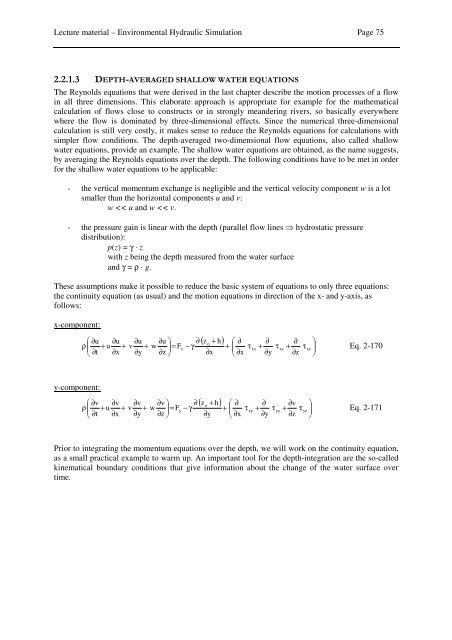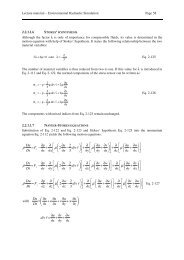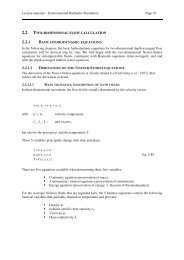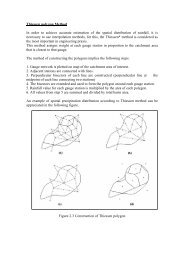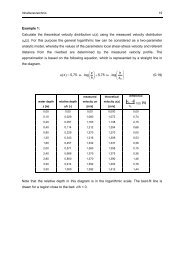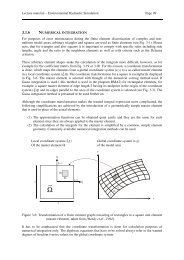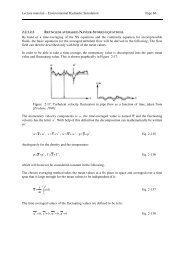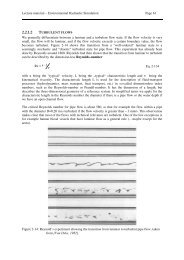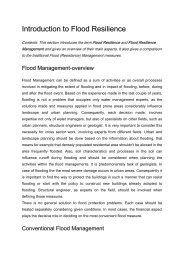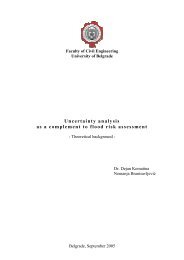Depth-averaged shallow water equation
Depth-averaged shallow water equation
Depth-averaged shallow water equation
Create successful ePaper yourself
Turn your PDF publications into a flip-book with our unique Google optimized e-Paper software.
Lecture material – Environmental Hydraulic Simulation Page 752.2.1.3 DEPTH-AVERAGED SHALLOW WATER EQUATIONSThe Reynolds <strong>equation</strong>s that were derived in the last chapter describe the motion processes of a flowin all three dimensions. This elaborate approach is appropriate for example for the mathematicalcalculation of flows close to constructs or in strongly meandering rivers, so basically everywherewhere the flow is dominated by three-dimensional effects. Since the numerical three-dimensionalcalculation is still very costly, it makes sense to reduce the Reynolds <strong>equation</strong>s for calculations withsimpler flow conditions. The depth-<strong>averaged</strong> two-dimensional flow <strong>equation</strong>s, also called <strong>shallow</strong><strong>water</strong> <strong>equation</strong>s, provide an example. The <strong>shallow</strong> <strong>water</strong> <strong>equation</strong>s are obtained, as the name suggests,by averaging the Reynolds <strong>equation</strong>s over the depth. The following conditions have to be met in orderfor the <strong>shallow</strong> <strong>water</strong> <strong>equation</strong>s to be applicable:- the vertical momentum exchange is negligible and the vertical velocity component w is a lotsmaller than the horizontal components u and v:w
Lecture material – Environmental Hydraulic Simulation Page 77Other tools are the Leibniz theorem and the fundamental theorem of integration, that both shall berestated in this place (just to make sure):Leibniz − theorem :z + hozooooo( )∂∂ z + h ∂zozoh zo∂x ∂x ∂x ∂xzo+ h zo+ h∂uo∫ u dz = ∫ dz + u+− uzzIntegration theorem :∫⎛ ∂u⎞⎜ ⎟⎝ ∂z⎠dz = u − uz + h zEq. 2-174With these instruments we tackle the integration of the continuity <strong>equation</strong> about the vertical axis, thatmeans between the bed z 0 and the free surface z 0 +h (with h being the <strong>water</strong> depth):z0+ h∫zo⎛ ∂u ∂v ∂w⎞⎜ + + ⎟ dz = 0⎝ ∂x ∂y ∂z⎠zo + h zo + h zo+ h∂u ∂v ∂wdz + dz + dz = 0∂x ∂y ∂z∫ ∫ ∫zo zo zo( )∂ z + h ∂zzo+ h∂oou dz − uzo+ h+ uzo∂x ∫∂x ∂xzofirst term( )∂ z + h ∂zo+ − +∂y ∂y ∂y zo+ h∂o∫ v dz vzo+ hvzozo second termzo+ hzothird term+ w = 0Eq. 2-175
Lecture material – Environmental Hydraulic Simulation Page 78In a little different form and substituting the kinematical boundary conditions yields:∂∂xz + h z + ho∫zoo∂u dz + v dz∂y∫zo( z h) ( z h)∂o+ ∂o+− u − v + wzo + h zo + h zo+ h∂x∂y ∂=∂h (temporal change of the surface)t∂zo∂zo+ u + v − wzo zo zo∂x∂y = 0 (no mass flux perpendiculat to the river bed)=0z + h z + hoo∂ ∂ ∂h⇒ u dz + v dz + = 0∂x ∫∂y ∫∂tzozoEq. 2-176Introduction of discharge as an integral of the flow velocity over the depth, and the depth-<strong>averaged</strong>flow velocities u and v (not to be confused with the symbols for the time-<strong>averaged</strong> fields mentionedbefore) we get:qxz + hoz + h=∫u dz = u h und qy=∫vdz = v hzoozoEq. 2-177The depth-integrated continuity <strong>equation</strong> can thus finally be stated as:( u h) ∂ ( v h)∂∂x+∂y+∂ h∂ t= 0Eq. 2-178The depth-integrated continuity <strong>equation</strong> shows that the difference between the flow into and out of avolume of <strong>water</strong> comes with a change of the <strong>water</strong> depth. The derivation of Eq. 2-178 has been donewithout simplifying assumptions. The <strong>equation</strong> represents the conditions exactly.Consequently we will do the depth-integration of the momentum <strong>equation</strong>s. The procedure is a littlelengthy, but we will go through it in detail anyway exemplary for the x-component.∂u∂u∂u∂u∂+ u + v + w = −g∂t∂x∂y∂z( z + h)o∂x+1 ∂ τρ ∂xxx+1 ∂ τρ ∂yxy+1 ∂ τρ ∂zxz+1FρxEq. 2-179
Lecture material – Environmental Hydraulic Simulation Page 79And depth-integrated:( z h)∂ ++ u + v + w dz + g dz =zo+ h zo+ h⎛ ∂u ∂u ∂u ∂u⎞o∫ ⎜⎟∂t ∂x ∂y ∂z ∫xz ⎝∂oz ⎠o temporal derivation +pressure termadvective term1ρ⎛ ∂ τ⎞⎜ + + ⎟⎝ ∂x ∂y ∂z ⎠zo + h z0+ h∂ τxxxy ∂ τxz 1∫horizontal viscouse term (1+2),vertical viscous term (3)dz + Fxdzρzo z0volume forces∫Eq. 2-180For better overview, the depth-integration will be done separately for each term. The first termincludes the derivative and the advection part. Then the Leibniz theorem will be applied to both thederivative and the two horizontal advection terms, and the fundamental theorem of integration will beapplied to the third advection term:zo+ h∫zo⎛ ∂u∂u∂u∂u⎞⎜ + u + v + w dz =t x y z⎟⎝ ∂ ∂ ∂ ∂ ⎠∂∂tzo+ h∫zo∂u dz +∂xzo+ h2∫zou∂dz +∂yzo+ h∫zou vdz− uzo+ h∂( z + h) ∂ ( z + h)o∂t− u2zo+ ho∂x−( u v)zo+ h∂( z + h)o∂y+( u w)zo+ hEq. 2-181+ uzo∂ zo∂t+ u2zo∂ zo∂x+o( u v) − ( u w)zo∂ z∂yzoThe components of this <strong>equation</strong> can be transformed so that the kinematical boundary condition can beapplied:zo+ h zo+ h zo + h zo+h⎛∂u ∂u ∂u ∂u⎞ ∂ ∂ 2 ∂∫ ∫ ∫ ∫⎜ + u + v + w ⎟ dz = u dz + u dz + uv dz⎝∂t ∂x ∂y ∂z ⎠ ∂t ∂x ∂yz z z zo o o o⎛⎞⎜⎟⎜∂h∂ ( zo+ h) ∂ ( zo+ h)⎟− u u v wzo + h ⎜ + + −zo+ h zo+ h zo+ht x y⎟⎜∂ ∂ ∂ ⎟⎜∂h= − ⎟⎝∂ t⎠+ uzo⎛⎜⎜⎜⎜⎜⎜⎝∂zo∂t= 0,because theriver beddo esn`t change⎞⎟⎟∂ zo∂ zo+ u + v − w⎟zo zo zo∂x∂y⎟ ⎟= 0⎟⎠Eq. 2-182
Lecture material – Environmental Hydraulic Simulation Page 81Considering <strong>equation</strong>s Eq. 2-181 to Eq. 2-183, we get the preliminary depth-integrated momentum<strong>equation</strong> in direction of the x-axis:∂z h z h z h( ) ( ) ( ) ( )o + o + o +u h ∂ h2∂ ∂ z + h 1 ∂ τ h 1 ∂ τo xxxy+ ∫ u dz + ∫ u v dz = − g ∫dz + +∂ t ∂ x ∂ y ∂ x ρ ∂ x ρ ∂ yz z zo o oτ ∂ z τxx o xy ∂ z τo xz+ + −ρ ∂ x ρ ∂ y ρzo zo zoriver bedEq. 2-187( z h) τ ( z h)τ ∂ +xx o xy ∂ + τo xz− − +ρ ∂ xρ ∂ y ρzo + h zo + h zo+ h <strong>water</strong> level+ h 2 ω v sin θThe following expression will be introduced for the wind and bed shear stresses:( z h) τ ( z h)τ ∂ + ∂ + τ τρ ∂xρ ∂yρ ρxxo xyo xzwind,x− − + =zo+ h zz o + ho + handEq. 2-188τ ∂ z τ ∂ z τ τso,xρ ∂xρ ∂yρ ρxxoxyoxz+ + − = −zozozoIn analogy to the time-averaging of the NS <strong>equation</strong>s, a division of the momentary vertical field into adepth-integrated mean value part and a deviation of the mean value is done. For the velocitycomponent in direction of the x-axis this division is:u (z) = u +~uEq. 2-189with u being the mean velocity over the vertical axis (not to be confused with the time-<strong>averaged</strong> meanvalue that has the same symbol) and u ~ being the deviation of the mean velocity. The following rule ofintegration holds for this division:zo + h zo+ h zo + h zo+h2( ) ( )∫ ∫ ∫ ∫u + uɶ u + uɶ dz = u dz + uɶ uɶ dz + 2 u uɶdzzo zo zo zozo+ h∫zo( )with uɶdz = 0 , uɶ= u z − u= 0Eq. 2-190
Lecture material – Environmental Hydraulic Simulation Page 82Substituting the expressions for the wind and bed shear stresses as well as the parts of the divisionfrom Eq. 2-187 into Eq. 2-185 yields the following depth-<strong>averaged</strong> momentum <strong>equation</strong> in direction ofthe x-axis:∂( )⎜⎛ 2u h⎟⎞u h∂ ( u v h)∂∂ t+⎝∂x∂−g h⎠+( zo+ h) 1 ∂ 1 ∂ 1+ ( h τxx) + ( h τxy) + ( τ − τ ) + h2ωvsinθ∂x∂y∂+∂xρ ∂xzo+ h∫zo~ ∂u~u dz +∂yρ ∂yzo+ h∫zo~u~v dz =ρwind,xso,xEq. 2-191As one of the last steps, the depth-integrated form of the continuity <strong>equation</strong> is isolated from the firstthree terms on the left side of the <strong>equation</strong> with help of partial differentiation.∂2( u h) ∂ ( u h) ∂ ( u v h)+ +∂ t ∂x ∂y( u h) ∂ ( v h)∂ u ∂ u ∂u ⎛ ∂ h ∂⎞= h + hu + hv + u ⎜ + + ⎟∂ t ∂x ∂y ⎝ ∂ t ∂x ∂y ⎠= 0depth int egrated continuity <strong>equation</strong>Eq. 2-192⎛ ∂u ∂u ∂u⎞= h ⎜ + u + v ⎟⎝ ∂t ∂x ∂y⎠Subsequently, we divide by the <strong>water</strong> depth and group the “fluctuating terms” with the viscous terms.We now get the momentum <strong>equation</strong> in direction of the x-axis:∂ u∂ t∂ u ∂ u+ u + v∂x∂y∂−g( z + h)o∂x+1h=⎡ ⎛ τxx⎢h⎜x ⎣ ⎝ ρ∂∂⎞⎤−~u~u ⎟⎥ +⎠⎦1h⎡ ⎛ τ⎢h⎜y⎢⎣⎝ ρ∂∂xy⎞⎤⎛−~ 1u~v⎟⎥+ ⎜⎠⎥⎦h ⎝τwind, xρτso,−ρx⎞⎟+ 2ωvsinθ⎠Eq. 2-193For a better overview, the general form of the depth-<strong>averaged</strong> continuity <strong>equation</strong> and the depth<strong>averaged</strong>momentum <strong>equation</strong>s, the so-called <strong>shallow</strong> <strong>water</strong> <strong>equation</strong>s:∂ui∂t1∂ui+ u j∂xj2( u i h)∂h∂+∂t∂xi= −g∂= 0o∂xi3( z + h)+1h∂∂xj⎡ ⎛ 1 ⎞⎤~ ~ 1 τwind ,i 1 τso,i⎢h⎜ τij− uiu⎟⎥j+ − + aFi⎢ ⎜ ρ ⎟⎥h ρ h ρ⎣ ⎝ 4 5 ⎠⎦where aF i= „acceleration component“ of the volume forces.6Eq. 2-194
Lecture material – Environmental Hydraulic Simulation Page 83The individual terms will now be explained shortly. The first term on the left side is the rate of change(over time) and the second term the convective momentum transport. The right side includes thegravitation force (third term) and the fourth term is the diffuse momentum transport with:∂u= µ∂x⎛+ ρ ⎜ν⎜⎝⎛⎜∂u⎝∂x∂uj+∂x⎞ ⎞⎟2− k δ ⎟⎟⎠3⎠iiτij,(m+ t)Tijjj iEq. 2-195The fifth term is the dispersive momentum transport, which is a mathematical result similar to theReynolds stresses – only by depth-integration. For uniform and homogeneous flows this term can beneglected. It describes the exchange processes due to vertical non-uniformities. If there is a strongsecondary flow, for example because of strong meandering, the dispersive term becomes important.The sixth term combines the forces from the outside, that is bed shear stress and wind shear stress. Thewind shear stress can be neglected most of the times, however.The bed shear stress is bound to the depth-<strong>averaged</strong> velocity by a quadratic velocity law.ττsoso= cf= cfρ u2ρ u u(allg emein)Eq. 2-196Here, c f is the friction coefficient, which can be determined according to the flow laws of Gauckler-Manning-Strickler or Darcy-Weisbach.Darcy-Weisbach’s flow law is definitely preferred.λλτ 0 = ρ u u ⇒ cf=Eq. 2-19788where drag coefficient λ can be determined with help of Colebrook & White’s formula as a function ofthe fields:f = cross section of form drag coefficient,Re = Reynolds number,ks= equivalent sand roughness,r = hydraulic radius.hyWhen using the Gauckler-Manning-Strickler flow law, it is of importance that the empiric k St -valuedepends on Re and r hy , i.e. the discharge state. The k St -value is thus no parameter of general, globalvalidity, but it has to be adapted to the discharge state.
Lecture material – Environmental Hydraulic Simulation Page 85In Eq. 2-198 and Eq. 2-199 all fields are time- and depth-<strong>averaged</strong>. Bars across, waves or other meansof symbol declaration for the time- and depth-averaging have been left away and will not be used inthe following chapters either.


